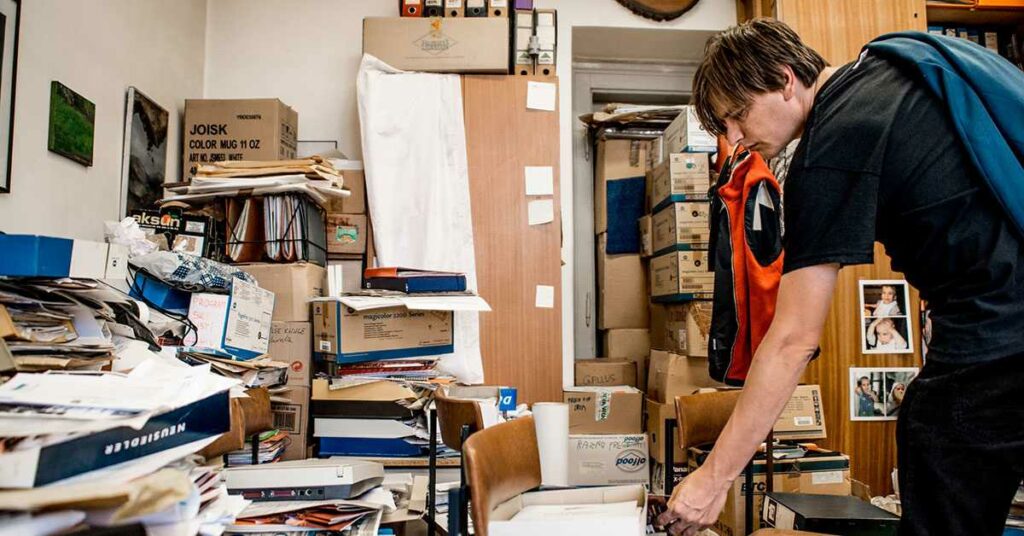What is compulsive hoarding? This is a question that many people ask, but don’t know where to find the answer. Compulsive hoarding is a mental disorder that affects many people around the world. It can be difficult to deal with, but there are steps that you can take to get help. In this blog post, we will discuss what compulsive hoarding is, its signs, its impacts, and how you can get help for it.
Contents
- 1 What Is Compulsive Hoarding?
- 2 What Are The Signs Of Compulsive Hoarding?
- 3 What Are The Causes To Have Compulsive Hoarding?
- 4 Are Compulsive Hoarding And OCD Related?
- 5 What Are The Effects Of Compulsive Hoarding?
- 6 How To Deal With Compulsive Disorder?
- 6.1 Identify The Problem
- 6.2 Set Some Goals For Compulsive Hoarding
- 6.3 Start With Small Steps
- 6.4 Make A Plan And Be Patient
- 6.5 Get Rid of Anything That Triggers Your Urge To Hoard
- 6.6 Find A Support Group
- 6.7 Talk To A Therapist
- 6.8 Change Your Environment
- 6.9 Seek Help From Family And Friends
- 6.10 Take A Break From Social Media
- 6.11 Don’t Be Too Hard On Yourself
- 7 Conclusion
What Is Compulsive Hoarding?
 Compulsive hoarding is characterized by an obsession with acquiring and holding onto possessions, even if they are of no real value. The hoarder may feel a need to save these items because they believe they will be useful in the future or have sentimental value.
Compulsive hoarding is characterized by an obsession with acquiring and holding onto possessions, even if they are of no real value. The hoarder may feel a need to save these items because they believe they will be useful in the future or have sentimental value.
It is often difficult for hoarders to get rid of their possessions, even if they are no longer needed or used. This can lead to cluttered and cramped living spaces, which can make it hard to move around and difficult to keep clean. Moreover, these people with hoarding disorder are known to be related to or have OCD.
According to studies, compulsive hoarding is defined as a mental disorder that affects around two to five percent of the population. It is also believed that those people with the disorder are more likely to be possessed by a perfectionist streak.
What Are The Signs Of Compulsive Hoarding?
There are various signs to identify compulsive hoarding. Here are some of the most common ones:
- Persistent difficulty in getting rid of or parting with possessions, regardless of their actual value. This difficulty is due to a perceived need to save the items and to the distress associated with letting them go.
- The accumulation of possessions often causes significant clutter and impairment to basic living activities, such as cooking, cleaning, moving about the home, and sleeping.
- There may be an excessive attachment to possessions, such that even items with little or no monetary value are retained (e.g., papers, rubbish).
- There may be beliefs about special powers or meanings ascribed to certain objects (e.g., “this old shirt will bring me good luck”).
- It is believed to have a need to collect specific items (e.g., newspapers, bottles, cans).
Also, it can very easily be characterized by an inability to stop acquiring things, even if they are not needed or have no use. These people include;
- An urge to collect things even if they’re of no use to them.
- These items clutter up their living spaces and make everyday activities difficult.
- There’s an emotional attachment to these items and they can’t stand the thought of getting rid of them.
However, these things create problems in day-to-day life. Moreover, compulsive hoarders may feel like they’re in control of their possessions. But in reality, their things are controlling them.
What Are The Causes To Have Compulsive Hoarding?
The causes are still unknown, but some experts think that they may be linked to OCD or depression. However, some of the causes of compulsive hoarding may include:
Traumatic event
This is one of the most common causes. A person who has gone through a traumatic event is more likely to develop compulsive hoarding. The trauma can be anything from the death of a loved one to losing everything in a fire. In fact, any event that causes a person to feel overwhelmed can trigger compulsive hoarding.
Genetics
It is believed that compulsive hoarding may be passed down from family members. If you have a parent or grandparent who is a compulsive hoarder, you may be more likely to develop the condition. Moreover, hoarders are more likely to have family members who also suffer from OCD or depression.
Brain chemistry
The chemicals in the brain may play a role in compulsive hoarding. For example, people with compulsive hoarding often have low levels of serotonin. This chemical is responsible for regulating mood and anxiety. Additionally, hoarders may also have difficulty processing information and making decisions. This is why hoarders often have a hard time getting rid of things even if they don’t need them.
Environmental factors
 Certain environmental factors can trigger compulsive hoarding. For instance, living in a cluttered or chaotic environment can cause a person to feel overwhelmed and stressed. This can lead to the development of compulsive hoarding. Also, people who live in isolated environments are more likely to develop the condition. As a result, they may start to hoard things as a way to cope with their loneliness.
Certain environmental factors can trigger compulsive hoarding. For instance, living in a cluttered or chaotic environment can cause a person to feel overwhelmed and stressed. This can lead to the development of compulsive hoarding. Also, people who live in isolated environments are more likely to develop the condition. As a result, they may start to hoard things as a way to cope with their loneliness.
Are Compulsive Hoarding And OCD Related?
There have been various studies conducted in order to find out if compulsive hoarding is, in fact, related to OCD. The results of these studies are still inconclusive; however, there are several key points that suggest the two might be connected.
First and foremost, both conditions share many of the same symptoms. For example, people with OCD often have difficulty throwing things away. Because they fear they might need it someday or that something bad will happen if they do. People with compulsive hoarding tendencies often feel the same way but to an even greater degree.
Furthermore, both disorders can cause significant distress and interfere with a person’s ability to function normally on a day-to-day basis. And finally, both OCD and compulsive hoarding tend to run in families, which suggests there might be a genetic connection.
Also, the compulsion is very similar. With OCD, a person experiences intrusive, unwanted thoughts (obsessions) that they feel they must do something about (the compulsions). These compulsions are usually an attempt to neutralize or reduce the anxiety caused by the obsessions.
With compulsive hoarding, a person feels the need to acquire and save large numbers of items because they fear something bad will happen if they don’t. They may even have delusions about the importance or value of these items. again similar to OCD where people often have hoarding tendencies as a result of their obsessive thinking.
What Are The Effects Of Compulsive Hoarding?
There are several effects of compulsive hoarding that can take a toll on your life. These include:
- Isolation and loneliness: When you hoard, you may start to distance yourself from friends and family. This is because you’re embarrassed about the state of your home and don’t want anyone to see it. Additionally, hoarding can make it difficult to move around your home, which can limit your ability to have people over.
- Financial problems: Hoarding can be expensive. Not only do you have to buy more stuff than you need, but you may also end up spending money on storage units or professional organizers.
- Health and safety concerns: If your home is cluttered and crammed with stuff, it’s a fire hazard. Additionally, you may be at risk for falls and other accidents. And if you have pets, their health and safety may also be at risk.
- Strained relationships: Hoarding can put a strain on your relationships. Your loved ones may not be able to understand why you hoard and they may get frustrated with you. Additionally, they may not want to spend time at your home because of the clutter.
The impacts of compulsive hoarding can be significant. And, it is very essential to get help if you or someone you know is struggling with this disorder. People must identify what they’re dealing with and start to make changes in their lives. Otherwise, the condition will continue to get worse and can eventually lead to serious problems.
How To Deal With Compulsive Disorder?
 When you somehow understand the reason behind your urge to hoard things, it will be easier for you to find a way to deal with it. The first step is always the hardest, but once you get started, it will get easier.
When you somehow understand the reason behind your urge to hoard things, it will be easier for you to find a way to deal with it. The first step is always the hardest, but once you get started, it will get easier.
Here are 11 steps that might help you deal with compulsive hoarding:
Identify The Problem
It is the very first step in overcoming compulsive hoarding. You need to be honest with yourself and admit that you have a problem. Once you do, it will be much easier to start looking for a solution. It is also referred to as “coming out of the closet” for hoarders. In fact, taking this first step is considered to be the most important one in overcoming compulsive hoarding. Because when you identify the problem, you are more able to deal with it.
Set Some Goals For Compulsive Hoarding
Setting goals is a great way to keep yourself on track when dealing with any sort of disorder or addiction. Having something to work towards can make the process less daunting and more manageable. Also, it is related to having real hope and no longer feeling helpless. When it comes to setting goals, be realistic and start small. Trying to do too much at once is likely to overwhelm you and make you feel like giving up. So, be patient, and take things one step at a time.
Start With Small Steps
Don’t try to do too much at once. If you try to change everything at once, you’re likely to get overwhelmed and give up. This is often referred to as the “all-or-nothing” mindset, and it’s not helpful when trying to overcome any sort of problem. So, start with small steps. For example, if you’re trying to de-clutter your home, start with one room or one area at a time. Or, if you’re trying to cut back on spending, start by cutting back on one type of purchase at a time.
Make A Plan And Be Patient
It is important to have a plan when you are dealing with compulsive hoarding. Having a plan gives you a sense of direction and helps to keep you on track. It is also important to be patient when implementing your plan. Remember that change takes time, so don’t get discouraged if things don’t happen as quickly as you’d like. Moreover, planning and being patient also go hand-in-hand with taking small steps.
Get Rid of Anything That Triggers Your Urge To Hoard
This can be done when you first identify your triggers. Once you know what sets off your urge to hoard, you can start to get rid of anything that triggers it. This might mean getting rid of certain items from your home or avoiding places that trigger your urges. Moreover, it is also important to get rid of anything that reminds you of your hoarding habits. This might include; pictures, journals, or anything else that brings back memories of your hoarding.
Find A Support Group

Support groups are a great way to find help and understanding. There are many different types of support groups available, so you’re sure to find one that’s right for you. You can find support groups online or in your local community. These groups provide a safe place to share your experiences and feelings with others who understand what you’re going through. In fact, some research suggests that support groups can be helpful in overcoming compulsive hoarding.
Talk To A Therapist
Considering therapists is considered a great step in overcoming compulsive hoarding. This is because therapists can help you understand the root cause of your disorder and develop healthy coping mechanisms. Therapists can also provide support and guidance as you work to overcome your disorder. If you’re not sure where to start, you can refer to visiting Mantra Care to get in touch with a qualified therapist. The team of Mantra Care also provides a free consultation at the first instance to clear the doubts.
Change Your Environment
As the environment plays a vital role in compulsive hoarding, it is important to make changes to your environment. This might mean making changes to your home or workplace. For example, if you know that certain areas of your home trigger your urge to hoard, make changes to those areas. This might mean de-cluttering or organizing those spaces. Or, if you have a lot of clutter in your home, consider moving to a smaller place.
Seek Help From Family And Friends
 Your family and friends can be a great source of support when dealing with any sort of disorder. It is often the case that family and friends are the first to notice when something is wrong. So, if you’re struggling with compulsive hoarding, don’t be afraid to reach out to your loved ones for help. They can provide support and understanding as you work to overcome your disorder.
Your family and friends can be a great source of support when dealing with any sort of disorder. It is often the case that family and friends are the first to notice when something is wrong. So, if you’re struggling with compulsive hoarding, don’t be afraid to reach out to your loved ones for help. They can provide support and understanding as you work to overcome your disorder.
Take A Break From Social Media
Social media can be a trigger for many people dealing with compulsive hoarding disorder. Because of this, it is important to take a break from social media. This might mean deleting your accounts or taking a break from using certain platforms. Moreover, it is also important to be mindful of the content you’re consuming on social media. If you find that you’re constantly comparing yourself to others. Or feeling triggered by what you see, it might be time to take a break.
Don’t Be Too Hard On Yourself
In the complete process, this is the most important thing to keep in mind. Beating yourself up will only make things worse. So, try to be understanding and patient with yourself. This is a process that takes time, so don’t expect to see overnight results. Overcoming compulsive hoarding is a journey and you deserve to be proud of every step you take.
If you or someone you know is struggling with compulsive hoarding, don’t hesitate to reach out for help. These are only some of the steps that might help you deal with compulsive hoarding disorder. If you feel like you need professional help, then go for it as soon as possible. Just remember that you’re not alone in this and there is help available.
Compulsive hoarding can be a difficult disorder to deal with, but it is possible to overcome it with the right support.
Conclusion
To conclude, compulsive hoarding is a serious problem that can have a profound impact on the individual and those around them. If you or someone you know is struggling with compulsive hoarding, there are steps that can be taken to deal with the issue. With proper treatment, many people are able to lead happy and healthy lives.
However, if left untreated, compulsive hoarding can lead to serious consequences, such as financial ruin, eviction, and even death. So, do not take this disorder lightly. Seek professional help if you or someone you know is struggling with compulsive hoarding.
If you are looking for affordable Online OCD Counseling MantraCare can help: Book a trial OCD therapy session


